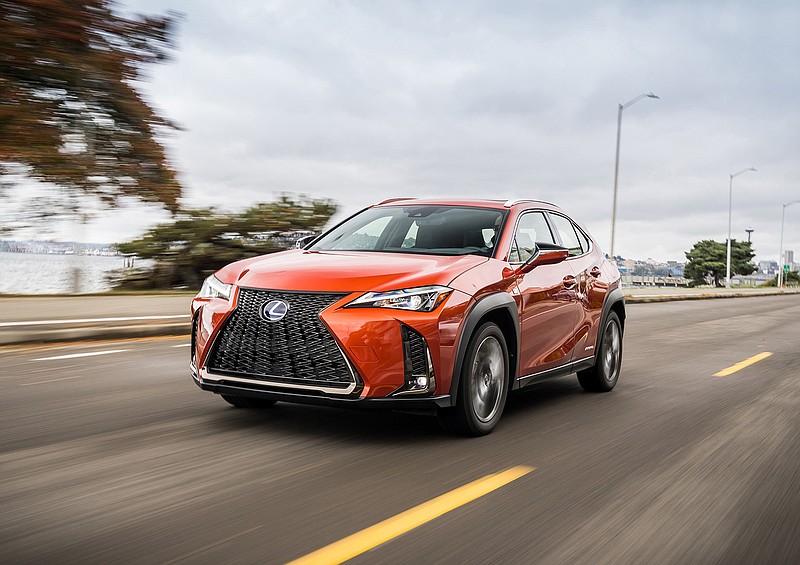I like to park darned close to the bush beside our driveway, but the 2019 Lexus UX was having none of it.
Photo Gallery
"Slumberland" Screening
August 5 & 6 a free screening of the new locally produced "Slumberland" was held at Riverdale 10 Cinema. Fans made donations to the filmmakers and enjoyed meeting the cast and crew.
First, it warned me of the proximate shrub. When I ignored that, the car just hit the dadgummed brakes. Ok, I'm at an age where I am comfortable with the notion that many people and some machines are smarter than me. Heck, I'm even getting past overprecision-the excessive conviction that one knows the truth.
One thing I'm certain is true, however, is that if you're a young, upwardly mobile buyer dipping your toe into the world of luxury compact SUVs selling in the $30,000 - $40,000 range, there is no way I can tell you which is best. The Mercedes GLA-Class, BMW X1, Volvo XC40. Infiniti QX30 and Acura RDX all were created by teams led by world-class engineers and each has its strong points. No wonder the competent and comfortable Buick Envision comes with hefty sales incentives.
The UX stands for urban crossover, a vehicle designed to negotiate cyclist-crowded streets and jam-packed parking lots while delivering the feel and sophistication of a Lexus.
"The Lexus UX is designed for the modern urban explorer seeking a fresh, contemporary and dynamic take on luxury driving," said Chika Kako, chief engineer of the UX. "We designed the UX to appeal to young buyers who seek not only what is new and exciting, but what is also relevant to their lifestyles."
Mission accomplished. The baby Lexus isn't as powerful as some rivals, but it is more comfortable, quieter, less expensive to operate, and comes standard with technology that the others either charge thousands more for or simply do not have.
Urban car
The first Lexus built on the same lightweight, super-rigid platform as the Toyota Prius and CR-H, the UX benefits from the architecture's exceptionally low center of gravity-23.4 inches-which results in crisp handling and a cabin insulated from road imperfections.
To that Kako's team added refined suspension tuning and enhanced sound-deadening technology (even the sound of water coming off the wheels is damped) to produce a small vehicle that rides like a Lexus.
A unique ring structure around the rear opening and behind the rear seats increases torsional rigidity to enhance crash performance, improve handling and reduce noise and vibration. Paying careful attention to little details like the quality of damper oil, oil seals and friction control all help improve ride quality.
Then the technology kicks in. Standard on the 2019 UX is ACA, active cornering assist. Integrated with vehicle stability control and the car's many sensors-we'll get to that-the car traces a driver's desired line through a curve and discreetly applies brakes to the inside wheels to overcome our human instinct to understeer.
The system is imperceptible in operation. The driver simply experiences a smooth-riding car with terrific steering precision and stability.
A best-in-class, 34-ft., curb-to-curb turning diameter makes the UX an in-town driving champ. U-turn? You know it.
"Seat-in-Control"
Sit in the driver's seat and one of the UX's most impressive charms is immediately apparent. Similar to how Pontiac used to bias center-mounted gauges toward the driver's line of sight, critical functions are grouped around the driver's seat. Even the infotainment system is angled that way.
The effect is quite pleasing. It is made all the more so because Lexus designed the seatback shape to allow the driver to operate all controls from a comfortable, natural position. It is enhanced if one chooses the optional heads-up display, which puts vital information in the driver's line of site.
At night, LED cabin lighting in the front footwells, glove box, and console switches enhance the perception of quality. Luxury-grade models feature illuminated vent controls with LED lights wirelessly powered by electromagnetic resonance of two magnetic coils. Mirror optics create an effect of deep floating light sources.
That's just cool.
The cabin is a mixture of expensive and inexpensive materials but exudes a sense of luxury. A contrast-stitched faux leather across the dash feels positively opulent. Available is a new trim finish inspired by the grain of Japanese paper, known as washi. It's common in traditional Japanese homes and evokes a calm and warm feeling.
Chief Engineer Kako drew on her extensive experience in materials development to help define the UX interior. The result is an uncluttered, "less is more" approach that makes the UX feel more inviting and accessible.
"When it comes to determining whether an interior is good or bad, controlling the overall balance between the continuity, unity, and contrast is more important than the relative specifications of individual components," she said.
Though the UX has one of the smallest cabin volumes (90.4 ft.3) in the segment, clever touches like fold-down grocery hooks and an optional hands-free, foot-activated power liftgate helped our tester easily absorb the fruits of a perhaps over-enthusiastic warehouse store run.
Brilliant
Built for technophiles, the UX knows how to do so many things. From a pair of rear-seat USB outlets to a sound system capable of playing highest-resolution audio formats to standard Apple CarPlay, the UX is built for upscale urban dwellers. Sorry, no Android.
Using a smartwatch, Amazon Alexa-enabled or Google Assistant device, owners can lock/unlock doors, start the engine or check their fuel level. A 4G Hotspot allows all occupants to stay connected to their worlds.
That's just scratching the surface. Standard safety gear includes a pre-collision system with pedestrian detection, dynamic radar cruise control, lane departure alert with steering assist, lane-tracing assist, road sign assist and self-dimming high beams.
Using a camera and radar, the car keeps an eye out for forward danger, even pedestrians in low-light conditions. First, it warns the driver. If no action is taken, it hits the brakes,
The same equipment controls the dynamic cruise control, which detects vehicles ahead and automatically adjusts speed to maintain a pre-set distance. It takes a load of stress off interstate driving.
Lane-departure monitors clear lane markings, road edges or curbs. If it decides the vehicle is unintentionally veering from its lane-because no turn signal has been activated-it alerts the driver. If the driver does not respond, an electronic power steering system will gently nudge the car back into its lane.
Lane tracing takes that a step further by automatically making small adjustments to keep the vehicle in its lane. Both systems are easily overridden with firm steering inputs from the driver, though I never found the need to do that. Usually, I just thanked the car.
Our tester came with parking support alert and brake. It activated twice, sparing the bush from being maimed and a badly parked pickup from a well-deserved ding.
Hybrid thinks ahead
But wait, there's more. Opt for the hybrid version, a $2,000 price difference, and you get Predictive Eco-Drive, a system that integrates your driving habits, real-time traffic alerts, and GPS information to optimize the hybrid system.
For example, when the UX approaches a location where the driver has slowed or stopped in the past, and the driver releases the accelerator pedal, it increases regenerative braking.
The system monitors the route for up to six miles ahead. This is useful because on a long, downhill stretch full charge can be reached partway down the hill. Any additional regenerated energy is wasted. Instead, the system calculates when a long downhill stretch of road lies ahead and then actively relies on battery-only driving to reduce the level of battery charge prior to that regeneration opportunity. The UX can run on battery-only power at up to 71 mph.
Yep, certainly smarter than me.
Enough power
Certainly, the biggest knock on the UX is power. The UX 200 has 169 hp, the 250 Hybrid 175. The Mercedes GLA-Class, by comparison, has 208 and the BMW 228. Certainly, if spirited driving is important, go German.
But let's think about this a moment. The others go faster because they have turbos under the hood. The naturally aspirated UX has under its hood is less heat, less complexity-all turbos break, it's a matter of when-and still gets from 0 to 60 in a respectable 8.6 seconds.
Here are two big differences, the mean combined fuel economy in the class is around 27 mpg. The UX 200 gets 33 mpg, that's an 18 percent difference. The 250 H gets 39, a 31 percent increase over the competitors.
But wait, there's more. Unlike the rivals, the Lexus entries run on regular unleaded. Not premium. This week in our neighborhood regular is $2.27 a gallon, premium $2.87. That's a 26.4 percent difference at every fill-up.
It's thinking like this that causes reviewers like Consumer Reports and Kelly Blue Book to choose Lexus and Toyota as the least expensive vehicles to own and operate.
Less gas, fewer repairs. Get it? That's one reason Lexus offers a 6-year/70,000-mile powertrain warranty when all the other guys put you on your own at 4-years/40,000 miles.
Subjectively, we put the UX 200 through its paces on the famed Wamba run and found it quite satisfying. Not the fastest car on the lot, to be sure, but one that would feel right at home zipping through the twisties up on the Talimena Scenic Drive.
Bottom line: We're sure Lexus marketing people know their audience. The Lexus 200 or 250 H will likely gain acceptance among the upwardly mobile young set, but it's also a fine choice for empty-nest Baby Boomers.


